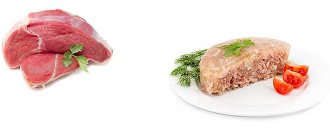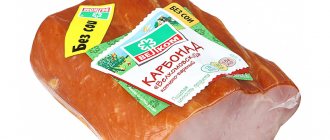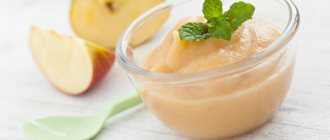Pork tongue is eaten boiled, baked, stewed or fried. It is served on the table as an independent snack, or used to prepare other dishes. In particular, aspic, salads, soups, homemade sausage, pates, pies and rolls are prepared using pork tongue.
Product selection and storage
When choosing a pork tongue, you need to pay attention to its texture and color. A high-quality product must have a smooth surface without damage, elastic and dense consistency. In order to check the freshness of the offal, you need to gently press it with your finger. Fresh pork tongue instantly restores its shape. At the same time, a small indentation remains on the surface of the spoiled product.
The color of the pork tongue also plays an important role. A high-quality offal has a scarlet, burgundy, lilac or violet hue. Gray pig tongues covered with droplets of cloudy liquid are unsuitable for food. A fresh product always has a light meaty aroma. Any unpleasant odors emanating from the pork tongue indicate that it is spoiled.
After purchasing, the offal must be rinsed under running cold water and wrapped in a thick layer of cling film. In this form, it can be stored in the refrigerator for no more than a day. In order to extend the shelf life of pork tongue, it can be frozen. It can be stored in the freezer for up to six months. Boiled tongue remains fresh for 3 days.
Delicious salad with pork tongue
This salad can be a holiday dish. It is original in its ingredients. But it's easy to prepare. For this dish you need to take:
- 500 grams of pork tongue;
- three eggs;
- 150 grams of Korean carrots;
- 70 grams of canned peas;
- one apple;
- salt and mayonnaise - to taste;
- some green onions.
To begin with, the raw tongue is washed, filled with cold water, salted and boiled for at least an hour. If necessary, hold it longer until it becomes soft. Place the finished tongue in cold water and then clean it. Cut the cooled tongue into cubes.
The eggs are boiled. Cut into cubes. Place them in a salad bowl. Add Korean carrots. It should not be very long so that it can be easily taken. Therefore, you can trim it slightly. Add the peas, being careful not to get any liquid.
Peel the apple and remove the center. Cut into thin strips. Add the fruit and tongue to the salad bowl. Finely chop the green onions and place in a bowl. Add mayonnaise and salt to taste, mix everything thoroughly. Let the salad sit for about five minutes. Afterwards it can be served.
Vitamins in pork tongue
100 g of product contains the following vitamin-like substances and vitamins:
- thiamine (B1) – 0.148 mg;
- riboflavin (B2) – 0.358 mg;
- pantothenic acid (B5) – 0.642 mg;
- pyridoxine (B6) – 0.294 mg;
- folic acid (B9) – 3.106 mcg;
- cobalamin (B12) – 0.788 mcg;
- tocopherol equivalent, alpha-tocopherol (E) – 0.896 mg;
- ascorbic acid (C) – 4.349 mg;
- niacin equivalent (PP) – 7.495 mg.
The concentration of niacin is 4.386 mg per 100 g of pork tongue.
Pork tongue and its calorie content
Pork tongue belongs to the by-products of the first category. Only first-grade meat surpasses this delicacy in nutritional value. One pork tongue weighs between 250 and 450 grams. The delicacy is always in demand because it tastes good and has tender meat.
There are about 208 kcal per 100 grams of offal. Of these, carbohydrates account for approximately 59 kcal, fats – 115 kcal, proteins – 34 kcal, which provides 10% of the daily calorie intake.
Pork tongue, like beef tongue, is recommended for use by children and adolescents, people suffering from infectious diseases, kidney diseases, stomach or intestines. There are many recipes for preparing delicious pork tongue dishes. But still, this product should not be abused, as excess weight quickly accumulates in the body due to the high calorie content of this product. Therefore, you need to know how to properly prepare salad, aspic or cold appetizers.
It is known that the calorie content of meat is greater than the calorie content of beef, pork, and lamb tongues. The tongue is easier and faster absorbed by the body due to the content of minerals and vitamins. An interesting fact is that the presence of calories in the tongue depends on the fatness and type of animal. The calorie content of pork tongue is higher than that of beef tongue, but less than that of lamb tongue.
In terms of fat content and the presence of proteins per hundred grams of product, pork tongue is superior to beef tongue. Although after cooking, the pork tongue remains juicy, tender and tasty. When boiled, meat loses most of its calories, which cannot be said about pork tongue, which retains most of its calories and minerals.
The calorie content of 100 g of pork tongue is 200-210 calories. The amount of fat and protein is approximately the same - 16 g per 100 g of edible part.
| Vitamin | Quantity |
| E | 1 mg |
| PP | 7.6 mg |
| B1 | 0.15 mg |
| B2 | 0.37 mg |
| B3 | 4.5 mg |
| B6 | 0.31 mg |
| B9 | 3 mcg |
| B12 | 0.79 mcg |
| Mineral | Quantity |
| Phosphorus | 165 mg |
| Magnesium | 21.9 mg |
| Potassium | 180 mg |
| Iron | 3.3 mg |
| Cobalt | 3 mcg |
| Calcium | 10 mg |
| Manganese | 0.02 mg |
| Sodium | 94 mg |
It depends on many factors that a person cannot influence. In particular, a direct relationship is observed between the calorie content of the offal and the fatness of the animal of which it was a part during its lifetime. But there are factors that can be influenced. For example, you can choose the most dietary method for preparing offal, which will suit you with its performance.
For example, if you take beef tongue, then in one hundred grams of boiled product there are about 175 calories. By the way, if you buy veal tongue rather than beef tongue and boil it, you can gain a little in terms of calorie content of the dish. There are about 163 calories in one hundred grams. If the beef offal is cooked in jelly, that is, made as jellied, then the numbers will increase to 208–210 calories per hundred grams. But the lowest calorie content is demonstrated by the grilled delicacy. In this case, there are 140 calories per 100-gram serving.
The caloric content of pork tongue will be much higher. If you boil it, then a hundred grams of food will contain about 185 calories. Although it must be admitted that when boiled, the offal loses about 20% of its calorie content. Indeed, in its raw form, the indicators reach 210 calories per hundred grams. This figure is even higher for a rarer delicacy - lamb.
Gourmets love it very much, because they know that lamb tongue tastes much more delicate than beef or pork. But its calorie content is the highest and reaches 223–225 calories per hundred grams (in raw form). If you boil it, then the figure for a 100-gram serving will drop to 195 calories.
More complex dishes in terms of recipes show different caloric content. For example, for beef and pork tongue baked in the oven, it is about 230 calories per hundred grams. But if you stew beef offal with sour cream, the calorie content of the dish will be 235 cal. For pork tongue stewed in sour cream, the figure is slightly higher and reaches 245 calories.
Beneficial features
- Pork tongue is a rich source of easily digestible protein, which is the main material for building muscle tissue. Therefore, dishes made from it can become the most important component of the diet for representatives of those sports disciplines in which special attention is paid to muscle detail and body aesthetics.
- The by-product contains a whole set of nutrients that accelerate regeneration processes in the body. Therefore, it is advisable to include it in the dietary menu for people recovering from injuries, surgical interventions or long-term illnesses. It is also useful for people engaged in heavy physical labor.
- Boiled pork tongue without spices has a relatively low energy value. Therefore, people seeking to lose weight can include it in their diet without fear of consequences.
- Regular consumption of pork tongue increases the body's ability to resist colds and infectious diseases.
- The nutrients that enter the body when eating dishes from this offal stimulate the production of hemoglobin, help in the fight against anemia and help improve the condition after heavy blood loss.
- Nicotinic acid and vitamin E, which pork tongue is rich in, improve the condition of the skin and its appendages (hair, nails).
- The zinc contained in this product helps normalize insulin production in the body. Therefore, dishes made from it bring invaluable benefits to people with diabetes.
- Pork tongue is rich in lecithin and B vitamins - substances that accelerate the renewal of brain cells, normalize the functioning of the nervous system, reduce the severity of symptoms of mental disorders, reduce the risk of developing neuroses and depression, and improve the quality of sleep.
- The nutrients contained in this product help speed up metabolic processes in the body.
- Pork tongue contains a whole complex of substances with antioxidant properties. Thanks to them, the production of free radicals slows down, the processes leading to aging of the body slow down, and the likelihood of developing cancer and degenerative diseases decreases.
- Regular inclusion of pork tongue in the diet helps normalize kidney function.
- The product contains substances that accelerate the elimination of toxins and other toxic substances.
- Healthy people who regularly eat pork tongue have the opportunity to increase the overall tone of the body, activate the brain, and improve the ability to remember large amounts of information.
How to cook pork tongue?
Due to the specific smell and taste, pork tongue is soaked in water before cooking. Having bought frozen tongue in a store, let it thaw in a cool place. This preserves all the beneficial properties of the product. If you purchased salted pork tongue, be sure to soak it in cold water for several hours and cook without adding salt. After this, the delicacy is boiled for 2-3 hours. Add to the broth - onion, bay leaf, parsley root and other spices to taste.
First of all, the tongue must be thoroughly washed, cleaned with a brush and the salivary glands and fat removed from its surface. To make the delicacy softer, it must be soaked in cold water for a couple of hours before cooking. Place a pan of water on the fire and bring to a boil. Now you can dip the prepared pork tongue into it. Cook it until tender, about an hour and a half. Readiness is checked using a fork. The finished product has a soft structure and, after piercing, clear juice flows out of it. When the tongue is cooked, immerse it in cold water for a couple of minutes and we can begin removing the skin. The whitish skin can be removed with a knife.
Calorie content of pork tongue
The weight of a pork tongue is about 220 grams. before cooking, and after it - about 2 times less.
It is good to cook pork tongue with spices, they make its taste richer and brighter. Before placing this delicacy in boiling water, you must add garlic, peppercorns, peeled and chopped carrots and onions.
No need to delay adding salt. The water boiled, they dipped their tongue into it, waited until it boiled again, and added salt.
Contraindications and harm
- Compounds present in pork tongue can cause allergic reactions.
- Pediatricians do not recommend introducing dishes from this by-product into the diet of children under 3 years of age.
- Nutritionists recommend limiting the consumption of pork tongue to 250 grams per day. Elderly people need to reduce the permissible volumes by half.
- Pork tongue contains a large amount of cholesterol. Therefore, it is contraindicated for people suffering from atherosclerosis and other cardiovascular diseases.
- Pork tongue dishes should be excluded from the diet if you have liver disease.
- Persons who have previously been diagnosed with enterocolitis, cholecystitis, gastritis and other disorders of the digestive tract should sharply limit the consumption of dishes from this by-product during exacerbations of existing pathologies.
- You should purchase pork tongue only from trusted suppliers who can guarantee that the content of pesticides, hormones and antibiotics in the meat does not exceed acceptable standards.








